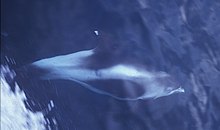Lagenorhynchus
| Lagenorhynchus | |
|---|---|

| |
Lagenorhynchus albirostris
| |
| Scientific classification | |
| Domain: | Eukaryota |
| Kingdom: | Animalia |
| Phylum: | Chordata |
| Class: | Mammalia |
| Order: | Artiodactyla |
| Infraorder: | Cetacea |
| Family: | Delphinidae |
| Genus: | Lagenorhynchus Gray, 1846 |
| Type species | |
Delphinus albirostris [2] Gray, 1846
| |
| Species | |
|
Lagenorhynchus albirostris | |
Lagenorhynchus is a genus of oceanic dolphins in the infraorder Cetacea, presently containing six extant species.[3] However, there is consistent molecular evidence that the genus is polyphyletic[4] and several of the species are likely to be moved to other genera. In addition, the extinct species Lagenorhynchus harmatuki is also classified in this genus.[5]
Etymology
The name Lagenorhynchus derives from the
Taxonomy
There is compelling
The remaining four species in the genus Lagenorhynchus—the
This phylogeny is supported by acoustic and morphological data; both the hourglass and Peale's dolphins share, with the other species of Cephalorhynchus, a distinctive type of
The melon-headed whale was first classified as member of the genus Lagenorhynchus, but was later moved to its own genus, Peponocephala.[11]
Notes
- ^ "Fossilworks: Lagenorhynchus".
- OCLC 62265494.
- ^ "List of marine mammal species". Society for Marine Mammalogy. Retrieved 30 December 2021.
- ^ a b c LeDuc, Perrin & Dizon 1999
- ^ "Fossilworks: Lagenorhynchus harmatuki". fossilworks.org. Retrieved 17 December 2021.
- ^ S2CID 92421374.
- PMID 31633766.
- ^ a b May-Collado & Agnarsson 2006
- ^ Tougaard & Kyhn 2010
- ^ Kyhn et al. 2010
- ^ Nishiwaki, M. and K.S. Norris (1966). "A new genus, Peponocephala, for the odontocete cetacean species (Electra electra)". The Scientific Reports of the Whales Research Institute. 20: 95–100.
References
- Kyhn, LA; Jensen, FH; Beedholm, FH; Tougaard, J (June 2010). "Echolocation in sympatric Peale's dolphins (Lagenorhynchus australis) and Commerson's dolphins (Cephalorhynchus commersonii) producing narrow-band high-frequency clicks". Journal of Experimental Biology. 213 (11): 1940–9. PMID 20472781.
- LeDuc, R.G.; Perrin, W.F.; Dizon, A.E. (July 1999). "Phylogenetic relationships among the delphinid cetaceans based on full cytochrome b sequences". Marine Mammal Science. 15 (3): 619–648. ISSN 0824-0469.
- May-Collado, Laura; Agnarsson, Ingi (2006). "Cytochrome b and Bayesian inference of whale phylogeny" (PDF). Molecular Phylogenetics and Evolution. 38 (2): 344–54. PMID 16325433.
- Schevill, W.E.; Watkins, W.A. (January 15, 1971). "Pulsed sounds of the porpoise Lagenorhynchus australis". Breviora. 366: 1–10. OCLC 80876226.
- Tougaard, J; Kyhn, LA (2010). "Echolocation sounds of hourglass dolphins (Lagenorhynchus cruciger) are similar to the narrow band high-frequency echolocation sounds of the dolphin genus Cephalorhynchus". Marine Mammal Science. 26 (1): 239–45. OCLC 497138903.
